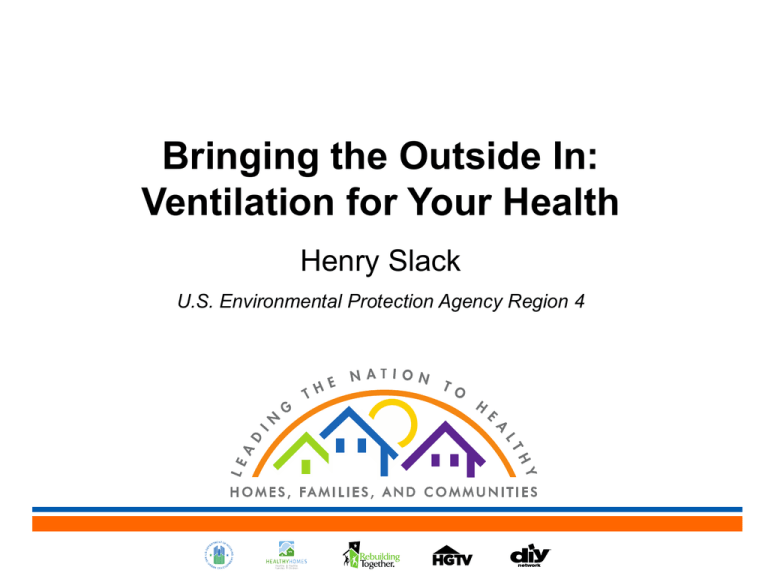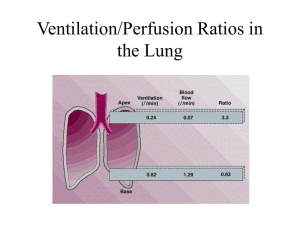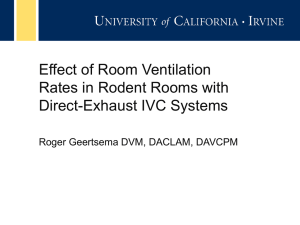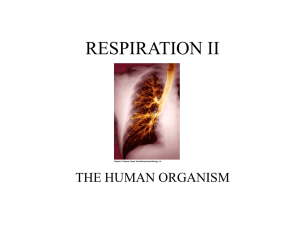Presentation 1 - National Healthy Homes Conference
advertisement

Bringing the Outside In: Ventilation for Your Health Henry Slack U.S. Environmental Protection Agency Region 4 Introduction to Air • • • • We breathe 20-30 lbs air/day ! 90% indoors – homes 70%, other bldgs 20% Indoor air: chemicals, mold, bacteria, dust Maybe high levels of radon, pesticides, tobacco smoke, combustion gases • How can we improve out household air? Ventilation! • • • • • • Cleans your air Lowers levels of every pollutant Health, productivity gain > energy $ Exploring ventilation, research Informational, but no firm conclusion U.S. EPA does not recommend ventilation quantities or delivery methods How We Built Homes Long Ago • Stone, wood, metal materials • Open windows half of year Outdoor Air = Indoor Air • Lathe and plaster walls (high pH) • Asbestos and lead-based paint • No central heat or A/C - unaffordable! Homes for the past 50 years • • • • • • Carpets, wallboard, Particleboard Finishes, glues, foam insulation Computers, printers, copiers (toner) Cleaning, personal, pesticide chemicals Central A/C and heat, filters Yes- shut windows, added chemicals Attached Garage • Storing gasoline, paint, pesticide, other chemicals • Autos (and if on, combustion gases) • Water heaters, even furnaces • No caulk or weather stripping between garage and kitchen = fumes come in Ventilation Recommendations • Florence Nightingale – 1860’s • She + others: around 60 cubic feet of air per minute per person (CFM/p) • Post-1973 energy crisis, the American Society of Heating Refrigerating, and Air-Conditioning Engineers (ASHRAE) recommended only 5 CFM/p in nonsmoking offices Ventilation 1980’s - now • A few years later, ASHRAE raised their recommendation to 15 CFM/p. • The present recommendation in office buildings is around 13 CFM/p, but the actual figure is calculated on the building size as well as occupancy, so it is not directly comparable. • The U.S. EPA does not set ventilation standards. ASHRAE Standard • ASHRAE’s recommendations were originally made as Standard 62, “Ventilation for Acceptable Indoor Air Quality.” In 2005, this standard was split into 62.1 for most buildings and 62.2 for residential buildings • Based on best science and “engineering judgment” so new science will change LEED • Leadership in Energy and Environmental Design (LEED) buildings could get extra credits for 30% more outside air than ASHRAE 62 Tight Homes • ASHRAE 62.2 recommends 0.3-0.35 air changes per hour (ACH) • Some new residences being built tighter without outside air ventilation • Multi-family as low as 0.03 ACH • Average across two studies: 0.10 ACH Three Key Ideas • CO2 may be a pollutant in ways not previously recognized • Meta-analysis shows health benefits of more OA level off around 50 CFM/person • More ventilation would pay for itself in offices and schools Meta-analysis of Ventilation Studies • Team of leading scientists reviewed 27 papers on health effects and ventilation written through 2005 • Higher ventilation rates in offices, up to about 25 l/s/person [50 CFM] are associated with reduced prevalence of Sick Building Syndrome symptoms How Much Outside Air Do We Need? • 2011 Meta-analysis reviewed 27 separate studies shows health benefits from delivery of more outside air. • Higher ventilation rates in offices are associated with reduced prevalence of Sick Building Syndrome symptoms (mostly respiratory). • The effect goes up to about 50 CFM/p (Sundell et al, Indoor Air 2011: 21; 191-204) 50 CFM/person is 3x Current Rates! • Consistency was found across multiple investigations and different epidemiologic designs for different populations • Suggests that lowering existing minimum ventilation rates inappropriate, but offered no support for any specific level of increase More on the Meta-Analysis • Consistent across multiple investigations, different countries, different research designs, so strong. • 50 CFM/p is 3-4x higher than ASHRAE Standard 62 recommends. This study did NOT recommend any particular amount of outside air • They also didn’t discuss using outside air when local air pollution is bad. CO2 • We all breathe out carbon dioxide (CO2) • CO2 levels may affect our ability to make decisions. • Typical levels have been viewed as harmless, although more CO2 makes our blood more acidic. • Outdoor air has around 400 parts per million (PPM) CO2 right now. A typical office building may see levels go up to More on CO2 • Outdoor air has around 400 parts per million (PPM) CO2 right now. • Offices may go up to 1,000 PPM (or 0.1%) during the day • Buildings without ventilation may go much higher • Submarines and space capsules may be 10,000 PPM or more • Decision Making Tests • Decision-making tests correlate with leadership skills. • Reliable: Tested on thousands of people • 22 subjects took tests. Same people, same room, same day, but the air held different levels of carbon dioxide (CO2) each time: 600 PPM, 1,000 PPM, and 2,500 PPM CO2 and Decision-making • 22 subjects completed tests of decisionmaking performance at 600, 1000, 2500 ppm CO2 , all the same day, but in different order • Validated decision-making tests (SMS) Satish, U., et al. Enviro Health Perspect 120: 1671-1677 Result • Result : statistically significant consistent downward trends on 7 of 9 decision scales Slides • Tests were double-blind: neither the subjects nor the technicians giving the tests knew what CO2 levels were present. • They even changed the order of the CO2 concentrations tested, so that the subject’s level of alertness would not be a factor. Is Our Children Learning? • Many school classrooms are over 1,000 ppm; in TX, 21% peak CO2 levels were >3,000 ppm • Office CO2 levels may be higher in meeting rooms, where decisions are made Does it Pay? • Many studies: more ventilation leads to greater productivity in schools, offices • 1% increase in vent: $3-10,000/year • Doubling ventilation yields productivity gains of $37 B (energy cost =$0.13 B). Economizers gain $33 B, saving energy but paying $0.28 B for equipment. (Fisk, Building and Environment, 2011 ) More on These Studies • So What About Ventilation? • Ventilation air can solve or improve almost any indoor air problem, • Cost: equipment and energy • Outdoor air must be better than indoors • Particulates, ozone concerns Humidity an Issue • Moisture from ventilation may change indoor moisture levels and comfort • Mold grows with moisture, too. • Brand new southern coastal school added outside air without moisture control. School closed within a year to dry and clean Bringing The Outside In Our Homes • • • • Deliver outside air in and push out IA Exhaust inside air and draw in OA Balanced methods do both No single choice Exhaust –Only Fans • In most bathrooms, many kitchens • Reasonable price, but… • Where does make-up air come from? – May draw in radon, mold, garage fumes – May bring in high-humidity air, grow mold – Does this air go to every room? Exhaust-only House • Shows fans on, bringing in outside air Supply-Only • Air source is known, air delivered into HVAC system to filter, dehumidify, change temperature • Pushes some air out, no problem. • More expensive, for equipment and for energy to treat the air • More complicated Supply-Only: CARB Study • Measured chemicals in newer homes • Homes had no OA system, supply-only system, or balanced systems • None of the 8 supply only systems was working properly • Chemical levels in these homes mirrored homes with no ventilation. Supply-only House • Shows fans on, bringing in outside air Balanced ventilation systems • Exhaust indoor air, deliver outdoor air • Heat exchangers transfer heat, save $ – Heat Recovery Ventilator (HRV) – heat only – Energy Recovery Ventilator (ERV) – heat and moisture, humid climates • More $ • CA : ERV homes= lower chemicals ERV/HRV House • Shows fans on, bringing in outside air Maintenance • HVAC requires maintenance. • Recommended 2x/year • Not always done, and not done on ventilation equipment Filtration • Filtration –needed on outside air intakes? • San Francisco Code 38 requires that outside air delivered to residences near freeways (which have high PM) must use a high grade of filter (MERV 13) to remove some of the PM. Other Issues • If air is mixed well, less ventilation? – Experts on both sides • Adjustable system? We set temperatures up and down – why not ventilation? Will we set too low? • Conclusion • Air quality is crucial to breath and health • Research suggests greater outside air ventilation would reduce chronic disease • “Best” system depends on location and equipment maintenance • U.S. EPA does not recommend ventilation quantities or delivery methods








